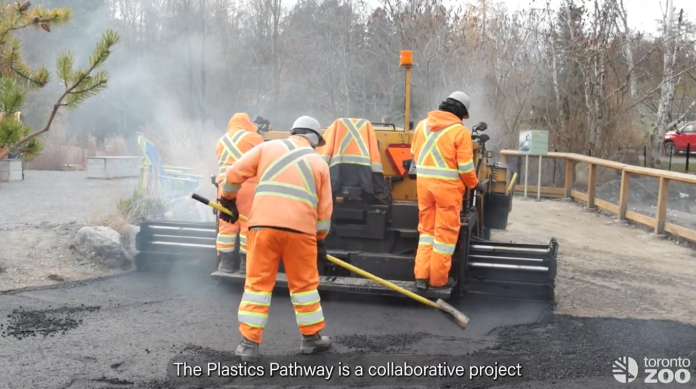Robin MacLennan
Ontario Construction Report staff writer
The Toronto Zoo reached a construction milestone last week, with a section of a new pathway being paved using asphalt mixed with recycled plastic.
“This project should inspire all of us to reimagine how infrastructure can help make the world sustainable,” said Steven Manolis, executive vice-president of materials engineering at GIP. “Engineering high-performance, long-lasting infrastructure with recycled materials is a great approach to sustainability.”
The Plastics Pathway is a collaborative effort involving Green Infrastructure Partners Inc. (GIP), who developed the recycled material and asphalt, and Vaughan Paving, the company that completed paving at the Toronto Zoo.
Traditional asphalt mixtures can degrade under Canada’s severe climate and heavy traffic, but the use of GreenMantra’s Ceranovus waxes, certified as 100 per cent recycled content, promises improved performance. These waxes are derived from various waste plastics, including film, milk jugs, food containers, and grocery bags.
Covering 470 square meters, the pathway integrates the equivalent of 100,000 plastic bags worth of post-consumer recycled plastic. This feat was accomplished by blending the asphalt with GreenMantra’s specialty polymer, which not only reduces plastic waste in landfills but also enhances the durability and lifespan of the pavement.
The project showcases how waste plastics, when converted into additives, can increase sustainability and add value to asphalt pavement.
“Infusing the pathway at the Zoo with GreenMantra’s product and asphalt formulated by GIP shows that hard-to-recycle plastics can be given a new life, keeping them in the economy and out of landfills,” said Christopher Hilkene, CEO at Pollution Probe.
Supported by the Province of Ontario, the Plastics Pathway initiative underscores the potential of plastic as a valuable resource when managed responsibly. It aims to increase public understanding and engagement through interactive exhibits about plastic in the environment, collection, recycling, and upcycling and serves as a real-life example of how hard-to-recycle plastics can be transformed into new, valuable products, offering practical solutions to the plastic pollution crisis.
“This project not only improves our sustainability but also educates our 1.3 million annual visitors on new technologies and approaches,” said Dolf DeJong, CEO of the Toronto Zoo. “By incorporating recycled plastics into our pathway, we are addressing challenging-to-recycle plastics and showcasing practical solutions.”

